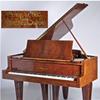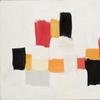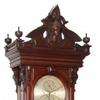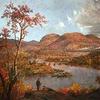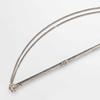Habitat California: Flora & Fauna Exhibition Assembles Contemporary Works Alongside Historic Paintings from Private Collections
- March 06, 2020 12:09
Southern California's Palos Verdes Art Center / Beverly G. Alpay Center for Arts Education has on view (through April 18, 2020) HABITAT CALIFORNIA: Flora & Fauna, an invitational and juried exhibition featuring the plants and wildlife of California in the shifting ecosystems they inhabit. The exhibition presents over 100 works of art in wide-ranging styles and media, including plein air landscape paintings, botanical drawings, and sculpture as well as installation art, video, film, and internet art. Topics include:
• Continuing the California Landscape and California Impressionist traditions
• The intersections of urban, suburban, and wildlife habitats
• The effects of climate change on wildlife and botanical habitat and species
• Explorations in new media featuring California flora and fauna and their ecosystems.
Contemporary works are accompanied by loans from private collections of 18th and 19th-century botanical prints and ornithologies as well as landscapes by noted early California artists, including William Wendt, Charles Reiffel, Edgar Payne, Clark Hobart, Theodore Robinson, and Ansel Adams.
The exhibit's juror, Tulsa Kinney, is the editor and co-founder of Artillery, a contemporary art magazine based in Los Angeles since 2006.
Among the historic works on view is "The Abandoned Mine" by Charles Reiffel (1862 – 1942), known a strikingly handsome man who wore his white hair long in order to cover a disfigured ear. His father had come from Bavaria to the United States in the 1840s and his mother was from an old Virginia family. He started his career as a lithographer and did not begin painting until 1912. Reiffel settled in Silvermine, Connecticut, where he was part of an informal group of artists called the Knocker’s Club, whose members met every Sunday morning to criticize each other’s work. In 1925, Reiffel and his wife planned a vacation through New Mexico and Nevada, but bad weather forced a detour to San Diego. They settled there permanently, and Reiffel became a leader in San Diego’s cultural scene.
Micajah Truitt is showing his photography as a member of the San Bernardino Cave & Technical Rescue Team. He explains, "It is a Search & Rescue Team with the San Bernardino County Sheriff Department. I have been working on a documentary project that tries to capture commitment, skill, and world that these team members participate in. During trainings and missions, I hold the role of participant, and the role of photographer. This is a long-term project. Over time, I am developing a series of images that shows various aspects of how these team members operate and work together. The images are taken from helicopters, while being suspended on rope, underground in caves and mines, and other environments such as snow-covered mountains. I also photograph many of the team members in their personal adventures such as mountaineering, rock climbing, canyoneering, and caving."
Another contemporary artist, Marianne Sadowski, is exhibiting from her series on the transformative power of fire. She says, "Layers of color and form frame the fire as a regenerative force rather than destructive. Recent California fires have brought devastation and sadness to entire communities. For many, climate change is now personal loss. The fires have also changed our landscape and its colors, at least for a moment. Dark burned trees stand quiet in contrast to the blue sky; entire hills are painted dark grey. And yet, with a little rain, there is also a green glimpse of hope emerging from the dark ground. The fire coexists with life. In these works it is seen as part of a larger cycle of life."
Born in Missouri in 1883, the major California impressionist Edgar Payne left home at age 14 and found work painting houses, stage sets and signs. Except for a brief period at the Art Institute of Chicago, he remained a self-taught artist. His first visit to California in 1909 was spent painting in Laguna before traveling to San Francisco where he met and married Elsie Palmer in 1912. In 1918, Payne established a studio-home in Laguna where he became the 1st president of the Laguna Beach Art Association and the 9th president of the California Art Club (1926). After extensive travel through Europe, he and Elsie established residency in New York before returning to Hollywood in 1932. A year later they separated. When Edgar developed cancer, Elsie returned to nurture him until his death a year later in Hollywood. Possessing a reverence for nature, Payne frequently he took pack horses in the Sierra Nevada Mountain Range to the upper lakes. His paintings glorified the area’s majestic peaks and cobalt blue lakes. Payne Lake was named in his memory.
Eric Stampfli's "Jane Magnolia" demonstrates his use of memory to create art. He explains, "Going back as long as I can remember I have always seen pictures in my head. At first ill formed like the fragments of a dream that I’m trying to remember this medium became the tool that I used to give definition to and make real those images. This is how I learned photography. It wasn’t about trying to capture a pretty sunset or portrait of a friend or the unfolding drama on a city street. It was alone in a studio learning to trust and ultimately reproduce the images I saw."
Born in Rockford, Illinois on Jan. 1, 1868, Clark Hobart moved to California with his family when he was a small boy. He studied art in San Francisco at the School of Design under Stanton and Cadenasso, and privately with William Keith. He then spent three years at the ASL in NYC under Blum and Bridgman and completed his art training in Paris. Returning to the U.S., he worked in NYC as art editor for the Burr-McIntosh magazine before moving to Monterey, CA. in 1911. The turning point in his career came in 1915 at the PPIE. During the exposition Hobart was awarded a silver medal and received praise from local art critics for his development of color monotype prints.
John Flores' current body of work portrays his personal interactions amongst nature. His sculpture, "Cycles," depicts the life cycle of a succulent called a lithop. This piece consists of multiple lithops in various stages of life, reinforcing the understanding of how precious and short lived life can be. These sculptures highlight the significance of having an interaction with the natural world, in hopes to evoke a desire from the viewer to reconnect with nature before it is gone.
Another contemporary artist, retired theater designer John Warren Travis, says "I carry my landscapes with me. From the pass to the north, deserts and mountains of El Paso Del Norte, where I was raised, onto my destiny, California, where I arrived in 1960. The abundance of nature from shore to mountains has constantly replenished my spirit. Now, in Columbia, Missouri with decided seasons of snow, spring, summer, and autumn, my work attempts to capture the ineffable power of nature–a spring from my graying. Not renderings, but reminders of this fragile terrain."
"I love the act of painting," Travis says, "And oddly enough, at the age of 87, I am beginning to see improvement."






